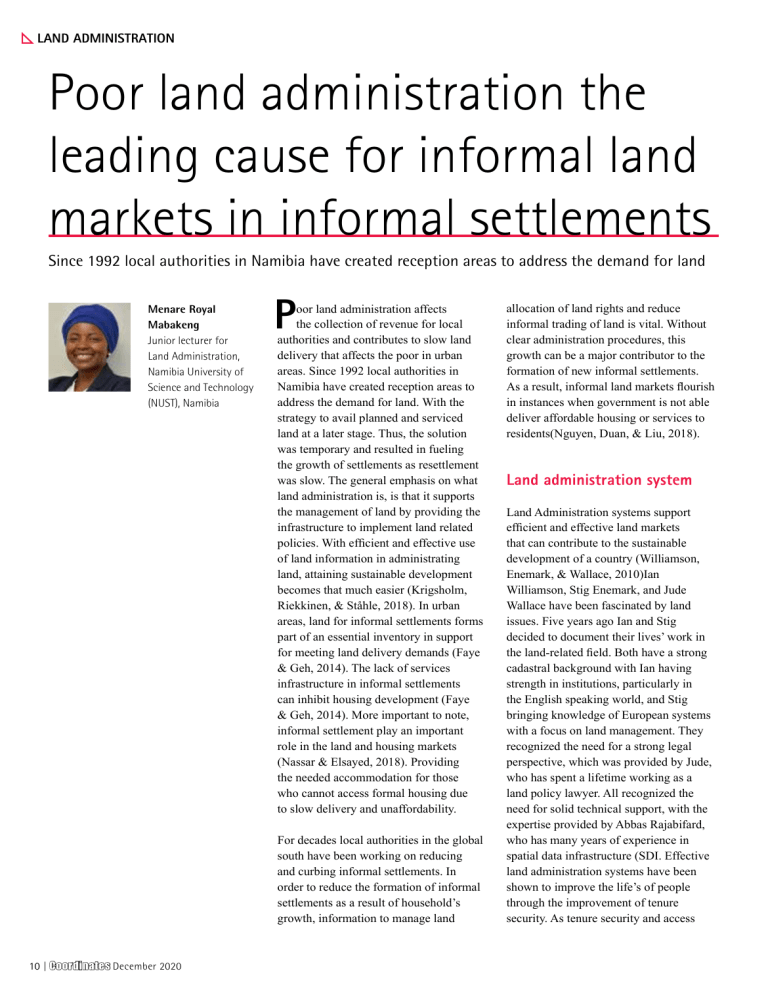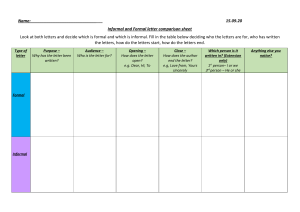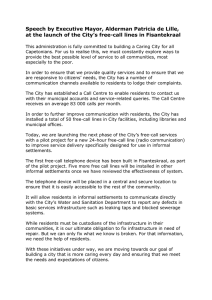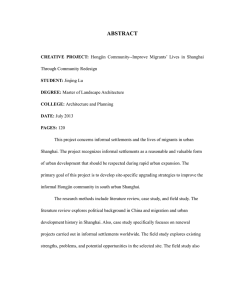Land Administration & Informal Settlements in Namibia
advertisement

LAND ADMINISTRATION Poor land administration the leading cause for informal land markets in informal settlements Since 1992 local authorities in Namibia have created reception areas to address the demand for land Menare Royal Mabakeng Junior lecturer for Land Administration, Namibia University of Science and Technology (NUST), Namibia P oor land administration affects the collection of revenue for local authorities and contributes to slow land delivery that affects the poor in urban areas. Since 1992 local authorities in Namibia have created reception areas to address the demand for land. With the strategy to avail planned and serviced land at a later stage. Thus, the solution was temporary and resulted in fueling the growth of settlements as resettlement was slow. The general emphasis on what land administration is, is that it supports the management of land by providing the infrastructure to implement land related policies. With efficient and effective use of land information in administrating land, attaining sustainable development becomes that much easier (Krigsholm, Riekkinen, & Ståhle, 2018). In urban areas, land for informal settlements forms part of an essential inventory in support for meeting land delivery demands (Faye & Geh, 2014). The lack of services infrastructure in informal settlements can inhibit housing development (Faye & Geh, 2014). More important to note, informal settlement play an important role in the land and housing markets (Nassar & Elsayed, 2018). Providing the needed accommodation for those who cannot access formal housing due to slow delivery and unaffordability. For decades local authorities in the global south have been working on reducing and curbing informal settlements. In order to reduce the formation of informal settlements as a result of household’s growth, information to manage land 10 | Coordinates December 2020 allocation of land rights and reduce informal trading of land is vital. Without clear administration procedures, this growth can be a major contributor to the formation of new informal settlements. As a result, informal land markets flourish in instances when government is not able deliver affordable housing or services to residents(Nguyen, Duan, & Liu, 2018). Land administration system Land Administration systems support efficient and effective land markets that can contribute to the sustainable development of a country (Williamson, Enemark, & Wallace, 2010)Ian Williamson, Stig Enemark, and Jude Wallace have been fascinated by land issues. Five years ago Ian and Stig decided to document their lives’ work in the land-related field. Both have a strong cadastral background with Ian having strength in institutions, particularly in the English speaking world, and Stig bringing knowledge of European systems with a focus on land management. They recognized the need for a strong legal perspective, which was provided by Jude, who has spent a lifetime working as a land policy lawyer. All recognized the need for solid technical support, with the expertise provided by Abbas Rajabifard, who has many years of experience in spatial data infrastructure (SDI. Effective land administration systems have been shown to improve the life’s of people through the improvement of tenure security. As tenure security and access 0.05° 1 cm 0.02° HEADING ATTITUDE POSITION The Smallest Dual Frequency & Dual Antenna INS/GNSS NEW ELLIPSE-D » RTK Centimetric Position » Quad Constellations » Post-processing Software Ellipse-D Ellipse-N OEM RTK Dual Antenna RTK Single Antenna RTK Best-in-class SWaP-C Visit our website: www.sbg-systems.com This will ensure that all relevant sectors that contribute to the development of informal settlements are part of the planning and implementation. Furthermore, using a systems approach as a solution to informal settlement will promote good land governance. Through the promotion of participatory planning methods and transparent approaches to projects implementation to land information increases investors’ confidence within the land market. In order to make decisions that benefit the broader society sound land information is important (Sylla, Antonio, & Gitau, 2018). Despite a clear understanding on the use of land information for management, there is still a lack of knowledge in how land information can support planning, land development and revenue collection (Sylla et al., 2018). This is shown in the proliferation of informal settlements and poor management of land resources in urban areas. Background to informal settlements in Namibia Spatially, informal settlements are irregular areas with densely build structures subject to regular change(Gevaert, Persello, Sliuzas, & Vosselman, 2016). However, Kovacic and Giampietro, (2017), caution describing informal settlements based on physical characteristics, as this may mislead policy implementation. Because, descriptions of physical attributes navigate attention away from social constructs; that explains informality and growth (ibid).While Mahabir, Crooks, Croitoru, and Agouris, (2016) propose to consider both physical and social constructs to understand the complexities of slum/informal settlements. As this will provide details on what the main drivers are for people to stay in slums; therefore providing evidence for appropriate policies(Mahabir et al., 2016).The ending of informal settlements 12 | Coordinates December 2020 is reliant on an inclusive legal process (Reerink & van Gelder, 2010). The main cause for informal settlement development is rapid urbanisation, population growth, poor urban governance, (Durand-Lasserve & Selod, 2007) and the high cost of housing, poor land information systems and inappropriate land tenure systems (Alemie, Bennett, & Zevenbergen, 2015). Urbanisation is related to a perception that moving from rural to urban areas will provide better economic activities (Sietchiping, 2005). The growth of informal settlements is incited by urban dwellers who cannot afford to access housing under the formal system .Moreover, according to (van Gelder, 2013) the reason for informality is due to failure of legal systems to provide recognition to occupants. Since 1992 local authorities in Namibia have created reception areas to address the demand for land (Lankhorst, 2000). With the strategy to avail planned and serviced land at a later stage. Thus, the solution was temporary. As honourable as this plan for providing residential areas, it resulted in the overcrowding of reception areas due to the slow service delivery and poor management of land. Occupants in reception areas were left with no options to upgrade their housing and lived in constant fear of relocations (Lankhorst, 2000). Similar solutions are still being proposed for implementation to this date, as local authorities still provide temporary solutions for the informal settlement challenge. For majority of local authorities, securing the tenure of informal settlement residents is not a priority. Although, there was a difference observed during the campaigns for local authority elections. Occupants in Windhoek, the capital city of Namibia were given occupation certificates, which are similar to the Permission to Occupy certificates given to land Figure 1 Informal settlements in Gobabis Source: (Weber & Mendelsohn, 2017) right holders pre-independence. The majority of occupants in informal settlements have limited access to water, toilets and electricity. In Earlier this year in the capital city; Windhoek residents were faced with cases of Hepatitis E outbreak within the informal settlements on the periphery of the city (Shikongo, 2020). The outbreak could have been avoided with better access to sanitation facilities for residents. The lack of service delivery affects 40% (Nakale, 2018) of the urban population in Namibia is living in informal settlements. Stakeholders with the land administration sector do not have a common definition on which areas within urban areas are considered an informal settlement. Although a when a land related crisis is declared, a limited common understand of the problem hinders the design of sustainable solutions amongst the formal institutions responsible for upgrading informal settlements. It is suggested, that as urbanisation continues to put pressure on land in Namibia, local authorities need to find strategies to better manage and improve land delivery(Indongo, 2015). The The challenges faced by local authorities with the management of urban growth and lack of service delivery is derived from poor land policy implementation as it provides communities with an opportunity to contribute to the improvement of their houses challenges faced by local authorities with the management of urban growth and lack of service delivery is derived from poor land policy implementation as it provides communities with an opportunity to contribute to the improvement of their houses. To understand use of data with the land administration systems for managing urban land Delivery, A Town In Namibia Was Selected. Study area Gobabis is the regional capital of Omaheke region, 200 km from Windhoek. The town has a population of more than 19 000 according to the 2011 national census estimates, the local authority is a part two municipality according to the Local Authorities Act. The few functions of the municipality are to supply water to residents, provide and, maintain sewerage, and administer the land within its jurisdiction. In 2012 Gobabis had four major informal settlements serving as a space for about 40% of the urban population in the town. One of the settlements identified for relocation was Independence Island, also known as Owambo Block. The settlement had a population of 585 people, in 145 households. The majority of structures were self-build, made from zinc, plastic and occasionally a few with cardboard. The residents were to be relocated, as the land they occupied was earmarked for servicing. Figure 1 shows the location of the settlement between freedom square and Epako. Residents in this settlement were relocated to other settlements within Gobabis, as the land had to be serviced for formal housing construction. To date, there land has been serviced, yet no developments have taken place on the land. Use of data by local authority In Gobabis, community enumeration data is said to use for decision making. Enumeration data is information collected by communities focusing on demographics, location and socioeconomic situation, supported by the Slum Dwellers International Affiliated group, the Shack Dwellers Federation of Namibia. Figure 2 Owambo Block/Independence Island with analysis of water access for residents According to officials at the municipality, the information is important on informing the local authority on how the number of residents in informal settlements. As the municipality did not have Coordinates December 2020 | 13 If the data generated by the community is to be used in the future for; land recordation; decisionmaking or to prove ownership, there is a need for direct involvement of local authority officials in the management of the data. Allot of time is invested in the community data collection as observed in other studies, if this is not managed properly, it will be unusable in the future. The participation and ownership of community in enumerations is the element of power this information before. Despite this confirmation by the officials, the author could not identify specific decisions taken using data provided through community enumerations. Moreover, discussions with officials and community representatives showed that there is a disconnection between data collection and its use for planning. In 2017 respondents during field interviews raised concerns over the price of water meters for Freedom Square, saying they cannot afford the 300 NAD proposed by the local authority. If the local authority used the community enumeration data to decide on the price for water meters, the unemployment levels in the settlement and the affordability of households would have been taken into consideration. Majority of informal settlement residents in the town are unemployed. Rather, the pricing of water meters by the municipality was based on cost recovery and not information from the community. The case of Independence Island informal settlement provides a clear picture on how local authorities relocate residents without using data to provide sustainable solutions. Figure 2 shows a map that was used to propose for informal settlement upgrading for residents within that area, and to date those residents were relocated by the local authority, and data on individuals was not used to secure land rights. 14 | Coordinates December 2020 On tracing some household relocated, some residents have transferred their rights to use the land to other residents. The right to use the land is not issued by way of any certificate, rather it is inferred by the residents based on the relocation, access to services. Records do not exist on how this transactions took place at local authority level. The original occupiers either moved out of town or went to set up new structures in open spaces within or at the edge of existing settlements. The transfer of land was more common in Kannan informal settlement that was provided with electricity by 2016 by the local authority. More than 60 percent of the original occupants of the houses in Kanaan were not the current owners during a study carried out in 2017 as part of the authors thesis(Mabakeng, 2018). Securing land rights and Land Administration Securing land rights through land registration could benefit occupants in informal settlements, as the confidence in investments is increased (Nakamura, 2017). Through the investigation, the research showed that, the poor administration of land in local authorities lead to increase in the informal land market in urban informal settlement. As occupants who are allocated land end up selling the land right and set up structures elsewhere. The sale of land and property not only affects the local authorities, it slows down upgrading projects and leads to an increase in illegal land occupation. To curb the challenges experienced, local authorities should consider implementing pro-poor land administration for the management of land in urban areas in Namibia. This will ensure that data on informal settlements is collected and land rights are recorded. Stakeholders involved in the upgrading of informal settlements need to use a systems approach for the management of land. Taking into consideration all the services and institutions needed for a functioning upgrading project. This will ensure that all relevant sectors that contribute to the development of informal settlements are part of the planning and implementation. Furthermore, using a systems approach as a solution to informal settlement will promote good land governance. Through the promotion of participatory planning methods and transparent approaches to projects implementation. Community awareness on the importance of land rights recordation and registration is vital to ensure that residents can derive benefits from the new registration approach. If the data generated by the community is to be used in the future for; land recordation; decision-making or to prove ownership, there is a need for direct involvement of local authority officials in the management of the data. Allot of time is invested in the community data collection as observed in other studies (Rigon, 2017), if this is not managed properly, it will be unusable in the future. The participation and ownership of community in enumerations is the element of power. However limited community engagement hinders the success of community enumerations especially in advancing community development priorities, which was a major element of success when the CLIP was initiated(Muller & Mbanga, 2012). References Alemie, B. K., Bennett, R. M., & Zevenbergen, J. (2015). A socio-spatial methodology for evaluating urban land governance: the case of informal settlements. Journal of Spatial Science, Vol. 60, pp. 289–309. https://doi.org/ 10.1080/14498596.2015.1004654 Durand-Lasserve, A., & Selod, H. (2007). The formalisation of urban land tenure in developping countries. 1–47. Retrieved from http://siteresources.worldbank. org /INTURBANDEVELOPMENT/ Resources/336387-1269364687916 /6892589-1269394475210/ durand_lasserve.pdf Faye, E. M. B. I., & Geh, Z. F. (2014). Market Dynamics Housing market dynamics in Africa. In Texas Mineral Resources (Springer e). https://doi.org/http:// dx.doi.org/10.1057/978-1-137-59792-2 Gevaert, C. M., Persello, C., Sliuzas, R., & Vosselman, G. (2016). Informal settlement classification using point-cloud and image-based features from UAV data. ISPRS Journal of Photogrammetry and Remote Sensing, in press, 225–236. https:// doi.org/10.1016/j.isprsjprs.2017.01.017 Indongo, N. (2015). The Effect of Urbanisation on Housing Conditions in Namibia. International Journal of Humanities Social Sciences and Education, 2(7), 1–8. Retrieved from www.arcjournals.org Kovacic, Z., & Giampietro, M. (2017). Between theory and quantification: An integrated analysis of metabolic patterns of informal urban settlements. Energy Policy, 100, 377 –386. https:// doi.org/10.1016/j.enpol.2016.06.047 Krigsholm, P., Riekkinen, K., & Ståhle, P. (2018). The Changing Uses of Cadastral Information: A User-Driven Case Study. Land, 7(3), 83. https:// doi.org/10.3390/ land 7030083 Lankhorst, M. (2000). Land Tenure Reform and tenure secuirty in Namibia. In Legalising Land Rights and Poverty : (pp. 1–21). International, 34(1), 78–85. https://doi. org/10.1016/j.habitatint. 2009.07.002 Mabakeng, M. R. (2018). Investigating the Impact and Use of Community Enumerations on Tenure Security in Informal Settlements - the Case of Gobabis Municipality in Namibia (University of Twente). Retrieved from https:// webapps.itc.utwente.nl/library www/ papers_2018/msc/la/mabakeng.pdf Rigon, A. (2017). Intra-settlement politics and conflict in enumerations. Environment and Urbanization, (1998), 095624781770033. https://doi. org/10. 1177/0956247817700339 Mahabir, R., Crooks, A., Croitoru, A., & Agouris, P. (2016). The study of slums as social and physical constructs: challenges and emerging research opportunities. Regional Studies, Regional Science, 3(1), 399–419. https://doi. org/10.1080/21681376.2016. 1229130 Muller, A., & Mbanga, E. (2012). Participatory enumerations at the national level in Namibia: the Community Land Information Programme (CLIP). Environment and Urbanization, 24(1), 67–75. https:// doi.org/10.1177/0956247811435891 Nakale, A. (2018, October 4). 40 % of Namibians live in shacks. New Era. Retrieved from https://neweralive.na/ posts/40-of-namibians -live-in-shacks Nakamura, S. (2017). Tenure Security Premium in Informal Housing Markets: A Spatial Hedonic Analysis. https://doi. org/10.1016/j.worlddev. 2016.08.009 Nassar, D. M., & Elsayed, H. G. (2018). From Informal Settlements to sustainable communities. Alexandria Engineering Journal, 57(4), 2367–2376. https:// doi.org/10.1016/j.aej.2017.09.004 Nguyen, H. L., Duan, J., & Liu, J. H. (2018). State control versus hybrid land markets: Planning and urban development in transitional Hanoi, Vietnam. Sustainability (Switzerland), 10(9). https://doi.org/10.3390/su10092993 Reerink, G., & van Gelder, J.-L. (2010). Land titling, perceived tenure security, and housing consolidation in the kampongs of Bandung, Indonesia. Habitat Shikongo, A. (2020, March 11). Hepatitis E continues to spread. The Namibian, p. 6. Retrieved from https://www. namibian.com.na/198938/archive-read/ Hepatitis-E-continues-to-spread# Sietchiping, R. (2005). Prospective Slum Policies : Conceptualization and Implementation of a Proposed Informal Settlement Growth Model. Information Systems, 1, 4–6. Sylla, O., Antonio, D., & Gitau, J. (2018). LOW-COST LAND INFORMATION SYSTEM FOR SUSTAINABLE URBAN DEVELOPMENT : CASE EXAMPLES IN KENYA AND ZAMBIA OUMAR SYLLA , DANILO ANTONIO, JOHN GITAU United Nations Human Settlements Programme, Nairobi, Kenya Presenting author: Danilo Antonio danilo.antonio. FIG Congress 2018 Embracing Our Smart World Where the Continents Connect: Enhancing the Geospatial Maturity of Societies. van Gelder, J.-L. (2013). Paradoxes of Urban Housing Informality in the Developing World. Law and Society Review, 47(3), 493–522. https:// doi.org/10.1111/lasr.12030 Weber, B., & Mendelsohn, J. (2017). Informal settlements in Namibia : their nature and growth. Retrieved from https://www.researchgate. net/publication/322200418_ Informal_settlements_in_Namibia_ their_nature_and_growth Williamson, I., Enemark, S., & Wallace, J. (2010). Land Administration for sustainable development Land Administration for sustainable development. In Sustainable Development. Coordinates December 2020 | 15



